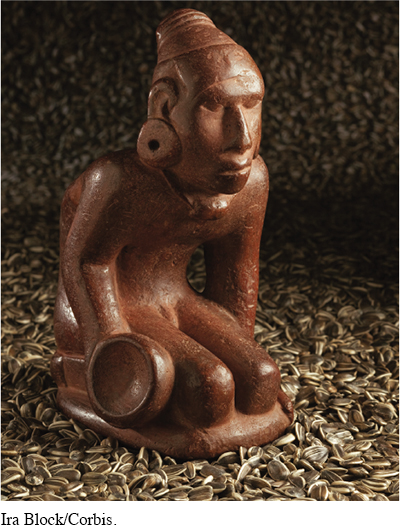Woodland Burial Mounds and Chiefdoms
No other ancient Americans created dwellings similar to pueblos, but around 2500 BP, Woodland cultures throughout the Mississippi River watershed began to build burial mounds. The size of the mounds, the labor and organization required to erect them, and differences in the artifacts buried with certain individuals suggest the existence of a social and political hierarchy that archaeologists term a chiefdom. Experts do not know the name of a single chief, nor do they understand the organizations chiefs headed. But the only way archaeologists can account for the complex and labor-intensive burial mounds is to assume that one person—whom scholars term a chief—commanded the labor and obedience of very large numbers of other people, who made up the chief’s chiefdom.
Between 2500 BP and 2100 BP, Adena people built hundreds of burial mounds radiating from central Ohio. In the mounds, the Adena usually included grave goods such as spear points and stone pipes as well as thin sheets of mica (a glasslike mineral) crafted into animal or human shapes. Sometimes burial mounds were constructed all at once, but often they were built up slowly over many years.
About 2100 BP, Adena culture evolved into the more elaborate Hopewell culture, which lasted about five hundred years. Centered in Ohio, Hopewell culture extended throughout the enormous drainage of the Ohio and Mississippi rivers. Hopewell people built larger mounds than did their Adena predecessors and filled them with more magnificent grave goods. Burial was probably reserved for the most important members of Hopewell groups. Most people were cremated, not buried. Burial rituals appear to have brought many people together to honor the dead person and to help build the mound. Hopewell mounds were often one hundred feet high and thirty feet in diameter. Grave goods at Hopewell sites testify to the high quality of Hopewell crafts and to a thriving trade network that ranged from present-day Wyoming to Florida.
Hopewell culture declined about AD 400 for reasons that are obscure. Archaeologists speculate that bows and arrows, along with increasing reliance on agriculture, made small settlements more self-sufficient and therefore less dependent on the central authority of the Hopewell chiefs who were responsible for the burial mounds.

Four hundred years later, another mound-building culture flourished. The Mississippian culture emerged in the floodplains of the major southeastern river systems about AD 800 and lasted until about AD 1500. Major Mississippian sites, such as the one at Cahokia, included huge mounds with platforms on top for ceremonies and for the residences of great chiefs. Most likely, the ceremonial mounds and ritual practices were influenced by Mexican cultural expressions brought north by traders and migrants. At Cahokia, skilled farmers supported the large population with ample crops of corn. In addition to mounds, Cahokians erected what archaeologists call woodhenges (after the famous Stonehenge in England)—long wooden poles set upright in the ground and carefully arranged in huge circles. Experts believe that Cahokians probably built woodhenges partly for ceremonies linked to celestial observations. The large plazas at Cahokia were used for religious and political ceremonies as well as for playing the Cahokians’ signature game of chunkey, which involved rolling a concave stone disk and trying to throw a spear that landed as close as possible to where the stone stopped. The game of chunkey spread throughout the region of Cahokians’ cultural influence, and chunkey stones are commonly found in Mississippian graves, signifying the importance Cahokians attached to chunkey in the hereafter as well as the here and now.[[LP Photo: P01.11 Cahokia Pipe/
Cahokia and other Mississippian cultures dwindled by AD 1500. When Europeans arrived, most of the descendants of Mississippian cultures, like those of the Hopewell culture, lived in small dispersed villages supported by hunting and gathering, supplemented by agriculture. Clearly, the conditions that caused large chiefdoms to emerge—whatever they were—had changed, and chiefs no longer commanded the sweeping powers they had once enjoyed.
> UNDERSTAND
POINTS OF VIEW
How did the adoption of agriculture shape ceremonies and ritual practices?
> QUICK REVIEW
How and why did the societies of the Southwest differ from eastern societies?
Understanding the American Promise 3ePrinted Page 16
Section Chronology